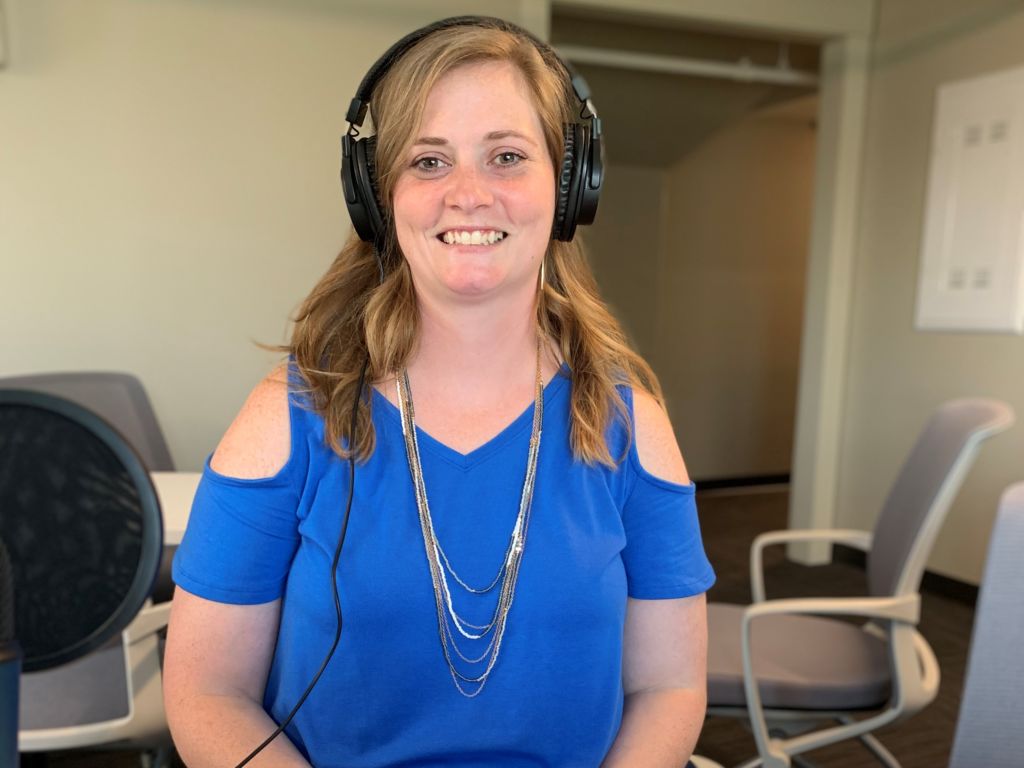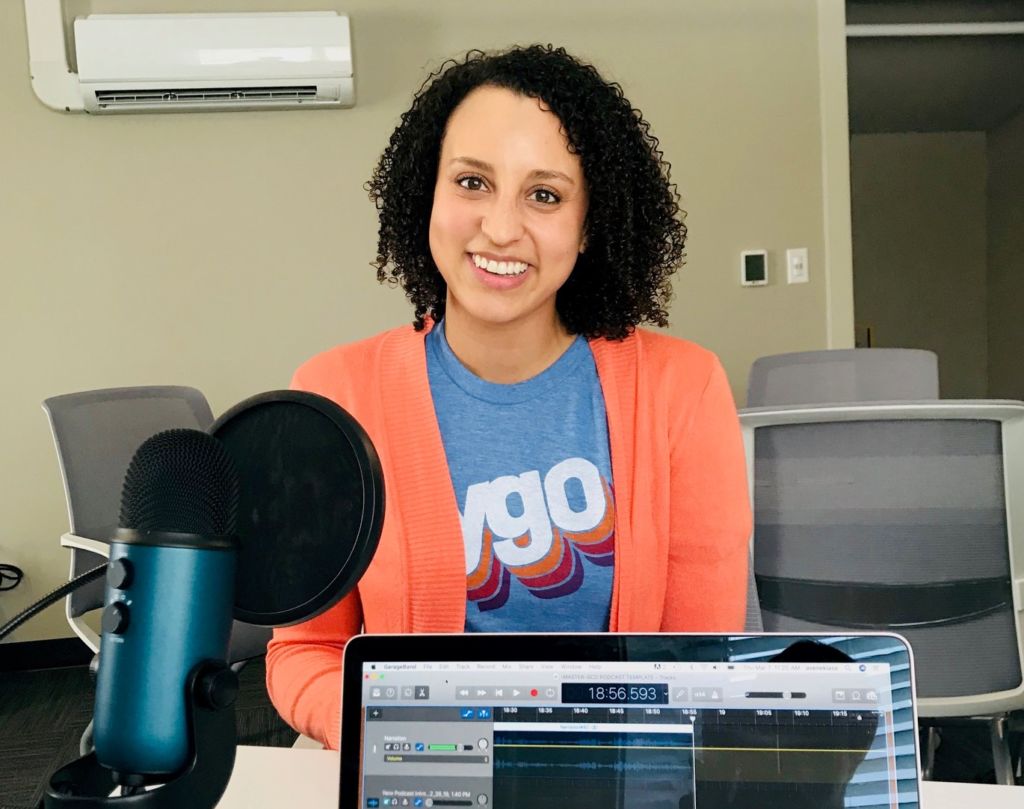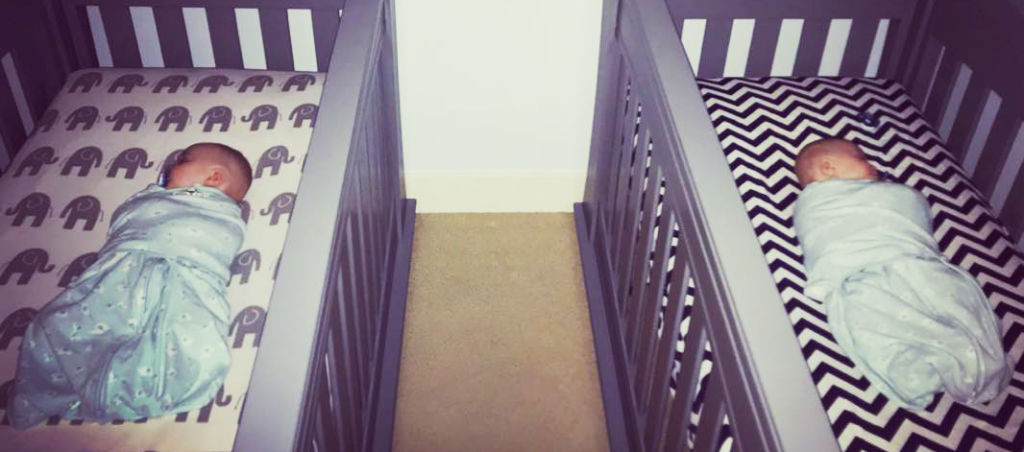Megan’s Sleep Story: Podcast Episode #80
Megan Kretz, one of Alyssa’s sleep clients, tells us about her sleep training journey with her daughter at 9 months and again at 19 months. She says that as a working mom, it meant spending a little less time with her daughter, but that it was all worth it because the quality of the time spent together improved drastically. Everyone was happier and healthier! You can listen to this complete podcast episode on iTunes or SoundCloud.
Alyssa: Welcome to Ask the Doulas Podcast. I am Alyssa, and today I’m excited to be talking to Megan Kretz. You were one of my past sleep clients, and then again recently.
Megan: Yeah, thanks for having me on!
Alyssa: Yes, we’re going to talk about sleep today. So remind me of how this journey began and what was happening before you called me.
Megan: So we reached out to you about when my daughter was nine months old with just all sorts of life problems as a result of my daughter’s sleep habits and our sleep habits, as well. A lot of it was definitely a struggle because we almost created the environment, the problem, that we found ourselves in.
Alyssa: Unknowingly.
Megan: Yes, unknowingly.
Alyssa: I mean, you don’t realize it when you’re doing it. You’re in survival mode.
Megan: Right. Before the age of eight months, my daughter had had five ear infections, and so we were in and out of doctors’ offices, on and off antibiotics, and because of that, she was in a lot of pain. She was seeking comfort because we could never get her comfortable. So in doing so, we just ended up creating all these really bad sleep habits. Falling asleep with us, on us, whatever we could do to allow mom and dad and baby to get some sort of rest. Up probably eleven times at night breastfeeding, and then wouldn’t take naps during the day; was up all day except for two 45-minute naps at the age of six, seven months old. Where our thoughts were going at that point was that she wasn’t developing properly without proper sleep. We couldn’t go on date nights. Nobody else could put my daughter down to sleep except me, not even her dad. We couldn’t go two hours for a movie on the couch without my daughter waking up, and it was getting to a point where, looking into the future, I don’t know how we would have gone much longer with the way that things were. And I had heard about you guys before, and finally I ended up going on the website, and I saw that you guys offer the sleep consultations. I was hesitant at first, but oh my gosh…
Alyssa: Didn’t she take to it, like, the first night?
Megan: Oh, yeah! The first night when we went through all of that — but I felt super needy with you.
Alyssa: No, you weren’t at all!
Megan: Texting you all the time! The first night, we had to go in and out, in and out a lot, but by the second night — she was almost there on the first night, and the second night, she was like, bam, done. She was like, I got this, Mom! I’m going to be your sleep champ from now on!
Alyssa: And kids always surprise parents. They want to sleep so bad, and once we just get them on a schedule, it just happens so much more quickly and easily than a lot of parents expect.
Megan: A lot of other working parents might find themselves in the same situation or scared on what they’re going to end up doing. I learned that so much of her night sleep is dependent on her daytime sleep and her nap schedule. She went to a daycare facility, and they had also used the same crutches we had to get her to sleep, and I was just nervous about that whole transition and really needing her to take proper naps in order to accomplish what we needed to at night. And in the end, we sorted out some schedules. We had some people that came and helped us and pulled her out of daycare for a week.
Alyssa: Yeah, I remember that. You had somebody stay at the house, because that first week is pretty critical, and when you have two parents working full time, you can’t just take a week off.
Megan: No, you can’t!
Alyssa: To have your baby sleep. That’s not feasible. But yeah, you had a trusted babysitter come over, right?
Megan: Yeah, and I don’t remember how many days it was.
Alyssa: Oh, you had a doula come, too, for a couple days, didn’t you?
Megan: No. Well, you…
Alyssa: Must have been another client. Sometimes they’ll hire a doula to come stay either during the day overnight.
Megan: I remember you said there are so many days that it takes of consistent behavior development to actually –
Alyssa: Until it becomes a habit.
Megan: Yeah, until it becomes normal for them. So we just had to get through that, and we did.
Alyssa: Well, and especially because she was going to daycare. Daycare can totally muck things up, especially if it’s a large one and not an in-home daycare but a large one where they have 20 kids and maybe 15 of them are in the nursery, and they’re just, like, this is naptime, and if they’re not sleeping, we get them up, because we don’t want them waking the other babies up.
Megan: Well, that’s what part of the problem was is that she was in the nursery, and there’s 12 other babies in that room, and they all share a crib room together. And they couldn’t get her to sleep, and then she was waking up other babies. It was all downhill from there.
Alyssa: So they just say, all right, nap’s done.
Megan: Yep.
Alyssa: But after that five days of a consistent pattern, then she’s going to go back to daycare, and her body’s already on the schedule and already has a rhythm set, and it’s much easier to go back into that daycare environment and tell them, now she sleeps from this time to this time, and if she wakes up early, here’s what you have to do.
Megan: And daycare, you know, they made their own adjustments for what worked for them, too, so I gave them our schedule, but then they actually removed her from a crib and put her on a toddler sleep mat. They’re raised little beds, and I had to get a doctor’s note, but at the age of ten months, nine months, she was actually the only child in the room for months that slept on a cot.
Alyssa: Oh, so she was in her own room?
Megan: She wasn’t. She was blocked off from the other kids. So yeah, she was in a room by herself, but she was kind of blocked off with some shelving units so the other kids didn’t get all up in her business when she was sleeping. But she was on a cot, and that worked best for her because they found that she was anxious in the room with all the other kids in the cribs because all of her past memories were coming up, so changing her sleep environment was also to let them work according to the sleep plan, as well. So it ended up working well that way, and she ended up moving up into the next toddler room already on the cot where most babies have to go through this learning period for that.
Alyssa: So I remember in the beginning, you kind of struggled. You had this tug-of-war within yourself of, gosh, she’s sleeping amazing now, but now I miss these cuddles that I get at night.
Megan: Yeah, I remember that!
Alyssa: It was like, we have to find a balance here. It’s hard to go from being used to her there all the time, but that’s part of the problem is that she’s there all the time and nobody can sleep.
Megan: And at night when I’m giving her cuddles, she’s giving me cuddles, too.
Alyssa: Yeah, it’s hard to just let that go.
Megan: And then don’t forget about the readjustment to milk supply. That was a big thing, as well.
Alyssa: Yeah, breastfeeding changes. Your body eventually fixes itself…
Megan: But it takes a little while and some uncomfortable days.
Alyssa: Yeah, you’ll wake up leaking everywhere. I’ve told moms to sleep on towels for a couple nights if needed!
Megan: Oh, yeah, been there, done that!
Alyssa: Yeah, so we talked about, early in the morning when she wakes up, get some cuddles in, and then spend the weekends, like Saturday and Sunday mornings, just make that cuddle time in bed to get all that oxytocin, all these great hormones that you guys are sharing when you get these cuddles.
Megan: It’s funny that you say that because it’s almost a tradition now that she’s older. She calls her pacifier her “oh, no” because when she can’t find it and she’s upset, it’s an oh, no situation. So she has to leave her “oh, no” in her crib, and then we go and get a bottle of milk, and I ask her if she wants to snuggle. Sometimes I get her out of the crib and she’s like, “Snuggle!” because that’s our time together. So we do that when we’re reading books before bedtime now, because we no longer breastfeed or give her a bottle before bed, so we just read books and snuggle for five, ten minutes, and then in the crib she goes. And then in the morning it’s a good cuddle time, and I wake up a little bit early and get ready before she’s up so that I’m not rushed for time to get ready. Either my husband or I will devote that time to her.
Alyssa: That’s really smart. I was just talking to somebody earlier about the fact that sometimes kids are just waking up because they want to see you, so especially as a parent who works full time, you already have this guilt of, I haven’t seen my child all day, and now they’re sleeping all night by themselves, which is great, but when do I get to see them? When do I get to cuddle them? So when you do a nighttime routine and then in the morning, put that phone away. Don’t make the TV part of this process. Put that kid on your lap; cuddle; kiss. Read the book, whatever. Just get all the snuggles in you can. They get 30 minutes of your undivided attention, and they don’t know if it’s any different than eight hours. To them it’s just that mom and dad are here and loving on me, and that makes all the difference in the world.
Megan: I agree, and it was hard being a working mom when we were going through all of this because the time with her became less because the night wakings weren’t there. But the quality increased. Her behavior got a lot better. And I am a better mom by being a working mom because I can devote my attention better if I have some things that I do on my own, if I have a work life, as well. So I didn’t want to give that up, but readjusting and figuring out the quality time was a lot better when she was rested and herself.
Alyssa: That’s the key, yeah.
Megan: And it really shines this whole idea even more when we recently went on vacation, and it was a struggle because we were in a new environment. She was in her own bed, but we had to share a room with her, and although all that went fine, her behavior was like she was truly in the terrible twos. She’s only 21 months old now, but everything changed because we tried to stick to the schedule, but you’re on vacation, so there’s only so much that you can do. So immediately on the day that we returned from this week-long vacation, and she’s sleeping in her own environment and we’re right back to the same routine, it was immediate behavior change, and it just solidifies even more how important a sleep plan is and how important it is to make sure that they get the sleep that they need.
Alyssa: They thrive on it, and we think that we’re doing them a favor by letting them stay up late to play with their friends. Or the 4th of July; it’s not even dark for fireworks until 10:00; what am I going to do? We’re not doing them or ourselves any favors by letting them stay up because usually they’re a wreck for two days after that. They’re not going to sleep in the next day. More than likely. They’re going to be up early the next morning. It affects them so opposite of the logical thinking. But yeah, that’s the key. You’ve hit the nail on the head; you have to readjust and understand that you have less time together, but it’s more quality time, and her entire world has changed. She’s happier, healthier, developing at a better rate because we all need sleep for that to happen.
Megan: It’s funny that you brought up the whole fact that readjusting and going to parties and not keeping them up late and whatnot — it’s funny because it’s easy for my husband and I to say sorry, we’re leaving at 7:30 or 7:00 or 6:30, whatever we have to do, to get home and start the bedtime routine. The hardest part about all of that is not leaving early; it’s convincing your family members and your friends that this is what you’re going to do and that this is important to you and your family, because it’s almost like they’re the ones pressuring you to alter your child’s sleep schedule. So that’s come up a few times, especially around the holidays when your family members do holiday parties or gift openings starting at 6:00, and bedtime routine starts at 6:30. You’re like, sorry, guys, we can’t come.
Alyssa: Right, unless you want to bring a pack and play and put her to bed there.
Megan: Which we’ve done. When she was young enough, we did that, and that was fine. We do that sometimes with friends where we go over and put her to sleep in the pack and play. We try to avoid that as much as possible, and now that our friends have kids or are having kids, we schedule things at 2:00 in the afternoon instead. Dinner parties go from 3:00 to 7:00; they don’t go from 7:00 to 11:00.
Alyssa: Yeah, that is the hardest part, because you have to be so consistent, and when you get those dirty looks or the weird looks from your friends, like why do they always have to leave so early, it makes you kind of feel bad, but you know it’s worth it. You’re doing this because it’s worth it.
Megan: Yep, it is.
Alyssa: So then you called me again recently…
Megan: I did!
Alyssa: She was sleeping great, and then you made a pretty big transition. Tell me about that.
Megan: Yeah. She was always a little bit ahead of the other kids as far as walking and crawling and climbing and running, so she eventually started climbing out of her crib, and we started getting very nervous about possible injuries. Quite a few times, on the video in her room, we’d see her sitting on the edge of the crib, just teetering there. My husband really pushed for a change because we can’t be doing this. So we actually ended up moving her into a big kid bed at the age of 19 months. And I’m trying to take what I learned with you from when she was nine months and trying to apply it to a child that’s now a toddler. And it wasn’t working. And that’s when we contacted you and learned about how kids don’t learn about delay of gratification until they’re three years old. So she doesn’t understand what it means when we tell that if you stay in bed all night, we get special time together in the morning.
Alyssa: It makes no sense. She doesn’t understand that concept whatsoever.
Megan: No. And she can get in and out of the toddler bed. Yeah, she may not be falling out of it now, but my husband and I went back to doing whatever we’ve got to do to get this child to sleep. So her nighttimes got shorter because we ended up staying in bed and laying with her until she fell asleep. Our bedtime routine went to two hours; from twenty minutes to two hours. And then she wouldn’t sleep a full eleven hours at night, and then her nap became elongated to three hours. We were on a waitlist for a daycare at the time, so we had to hire a nanny for a couple months. And it was funny because we were paying her for an eight-hour day when our daughter is sleeping for three of them! Just kind of a funny fact. But we went right back to, oh my gosh, what do we do? A year later, I’m finding your email address and saying help! Is there anything that you can help us with? And then when you sent us our new sleep plan and we saw that there are clear ways to help a child stay in the bed and to go right back into a routine for this next stage of a child’s life, and that babies aren’t the same as toddlers. It was eye-opening again when we saw the second plan, and you had so much good information in there!
Alyssa: I always wonder if it’s too much.
Megan: No!
Alyssa: I geek out on sleep information, so I give my clients so much information. I think it’s imperative!
Megan: My husband even brought up later on about something else in the sleep plan that wasn’t related to sleep. Oh, it was snacking! You had said — and it’s so true. A lot of times, we were just allowing her to snack a lot, and we didn’t have set meals, necessarily. Yeah, she ate meals with us, but we allowed her to snack more than we snacked, not even thinking about how that might be tied into sleep or protein intake at certain times of the day and how that aids in sleep patterns. We had no idea. I was giving her a snack, and my husband actually said to me, don’t you remember reading that on Alyssa’s sleep plan?
Alyssa: That’s great! That’s what it’s there for!
Megan: Yeah, it was a lot of great information. And there’s just something special about receiving this information from a local person, from you, a person, and not a book I just pulled off the shelf at the library that might be outdated. You really cater our sleep plans to us, to the client and to the child, and having come in to our home, you knew us. You looked for things that might be distractions for quality sleep and taught us how to do a proper nighttime routine. Although it was a lot of information at one time, it was well-received, and we felt very — I don’t know if qualified is the right word, but we got the information we needed to then make good, informed decisions.
Alyssa: And be confident.
Megan: Yes, we got the confidence.
Alyssa: Even though I’m with you — you’re texting me all the time; I’m responding back; I’m there for guidance — but I’m not there forever. So that’s why I want you to have enough information that you can say, oh, okay, she’s twelve months now. Oh, yeah, she told me that this would probably happen around 12 months. Because I learned this when she was nine months, that’s what this means at 12 months. You have to be able to troubleshoot yourself or you’re just going to keep calling me every three months at every developmental milestone, saying what do I do? Help!
Megan: And it’s funny because we went back to your sleep plan multiple times between 9 months and 15 months to just look and what did she say when she reaches this age group; how much sleep will she need; what are her naps supposed to look like? So we definitely referenced it. But being in a new bed, when all that came up… And the plans themselves were very different.
Alyssa: Yeah, sleep is very different for a two-year-old versus a nine-month-old.
Megan: Yeah. But now, after day one of the new sleep plan, we got her back in the crib. It was like she never forgot it. She was in the big girl bed for probably four weeks.
Alyssa: So you’re thinking, oh, great, even if we try this plan, she’s ruined. We’re going to have to start all over.
Megan: Yeah, that’s exactly what I thought, but no, her sleep habits came right back. We were able to get her nap back down to a normal, respectable time, and she’s back to sleeping eleven, twelve hours at night with no interruptions. We can go back to watching movies and having quality time together with my husband.
Alyssa: And for date nights, babysitters are easy?
Megan: Oh, babysitters can put her sleep again. I’m not asking a babysitter to sleep with her for two hours.
Alyssa: “You’re going to have to lay in this bed with her, sorry!”
Megan: And then ever so slightly, quietly creep out as quiet as possible!
Alyssa: It’s like the ninja role. Like, you kind of slowly roll of the bed, and you keep a hand there for pressure and you slowly lift your hand up.
Megan: Make sure the dog is quiet when you’re moving around so its nail don’t click-clack on the hardwood floors and wake her up! Oh, I better put some WD40 on that door! Yeah, those were all things that were happening and going through our head. I’m laughing and I’m making a joke about it, but those were legitimate concerns of mine when we had her in the big girl bed and all of this was going on. Call me crazy, but that’s how you feel when you and your child aren’t getting sleep.
Alyssa: Well, you are a bit crazy. I mean, sleep deprivation does not make for a sound mental state!
Megan: And now I just can’t believe how much you guys have been able to help us. Maybe my experience can help other people. I’ve referred quite a few people over your way.
Alyssa: Thank you!
Megan: I just can’t reiterate enough how much you guys helped us and how worth it it is.
Alyssa: it’s definitely a service that I could literally call life changing.
Megan: Yes! I would call it that, as well! In fact, I think I’ve left reviews stating that!
Alyssa: Well, if you had one thing that anyone who has pushed off sleep training would need to hear, what do you think it would be?
Megan: It’s worth it. It is what’s best for baby. It’s what best for you and your family unit.
Alyssa: And what if they’re scared? Sleep training just causes anxiety. Those two words; people just think oh, this just sounds like it’s going to be a miserable experience. My child is going to be left alone; they’re going to have anxiety.
Megan: But she wasn’t left alone. The plan you gave us; that wasn’t the case, and you told me right from the beginning, before I even paid for anything, that we will do a plan according to what is comfortable for you. And I was totally okay with the plan. And what’s the worst that could happen? She wakes up 12 times at night versus 11? No, that’s not even going to be a possibility. We were so far down the rabbit hole that there was no getting deeper. We were hitting bedrock. So it could only get better at this point, and it did. It was a complete 180.
Alyssa: Well, I loved working with your family both times. You probably won’t need me again because she’s great. Don’t put her in that toddler bed until she’s three.
Megan: We won’t!
Alyssa: You’ll know when she’s ready!
Megan: We will definitely wait. Now we have just over a year before we have to make any new changes to sleep, but now I have the tools, too, to be able to transfer her to a big girl bed
Alyssa: Yeah, did I give some info to plan for?
Megan: You did, yeah!
Alyssa: Oh, good. I figured I did, but…
Megan: But this isn’t the end, Alyssa! I’m sure that we will see each other again and talk to each other again!
Alyssa: Well, on that note — because you might be adopting?
Megan: Yeah.
Alyssa: So I’m going to talk to you again at a later time about what an adoption process looks like because I don’t know, and a lot of our listeners and parents probably don’t know and maybe are even thinking about it but might be scared. SO we’ll talk about that next time.
Megan: I’d love to help you with some insight on there.
Alyssa: Thanks for joining us!
Megan: Yeah, thank you for having me!
Alyssa: If you have any questions for us, you can email as at info@goldcoastdoulas.com. You can also find us on Facebook and Instagram. Thanks, and remember, these moments are golden.
Megan’s Sleep Story: Podcast Episode #80 Read More »







